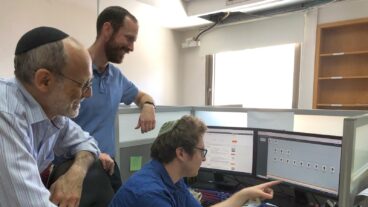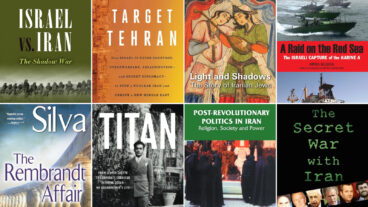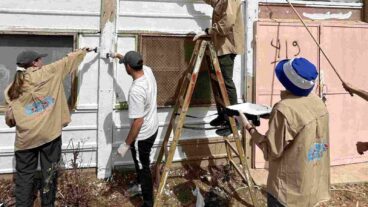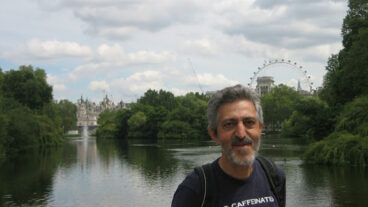Cutting-edge science addressing Dead Sea issues in a holistic way may eventually stabilize the whole region.The Dead Sea is anything but dead. But it is ailing.
Human exploitation has taken its toll on the area over the last 40 years. The Dead Sea’s shore has been receding at an alarming rate. Where once bathers used to take their buoyant healing baths at 393 meters below sea level, today they are floating in water some 20 meters lower.
But two Israeli researchers are leading a team from the Minerva Dead Sea Research Center at Tel Aviv University, which together with scientists from neighboring Jordan at attempting to diagnose different challenges in earth sciences that affect the Dead Sea region.
The greasy, salt-water may grow only bacteria but the ecosystem surrounding the Dead Sea is rich in both modern and ancient natural history. Historians say Dead Sea minerals were one of Cleopatra’s best-kept beauty secrets and researchers claim that long before Egyptians built the pyramids, the early hominids, our ancestors, used the Dead Sea corridor to migrate from Africa to Asia and beyond thousands of years ago.
“Imagine what could be trapped under the salt and minerals,” asks TAU researcher – Swiss-born Hillel Wust-Bloch.
“There are traces of ancient weather patterns waiting to be deciphered, as well as clues to mans’ early travels,” says Wust-Bloch who is working on the project with Minerva Center head TAU Professor Zvi Ben-Avraham, the foremost authority on Dead Sea research in the world.
The problems have to do with water consumption and business. As the Israeli and Jordanian populations grow, less and less water makes it in the end to the Dead Sea: water which helps the Dead Sea maintain its equilibrium. But Israelis face water shortages as do the Jordanians and precious drops which once flowed from Israel’s Lake Kinneret or Jordan’s Yarmuk River into the Dead Sea are now being used by humans instead.
To compound the problem, large industrial plants are draining the Dead Sea on its South shores. There, on both sides of the border, Israeli “Dead Sea Works” and Jordanian “Arab Potash” factories pump out rare and rich minerals. “The cosmetics market accounts only for spoonfuls of the minerals being depleted at the Dead Sea,” says Wust-Bloch, explaining that large industrial plants use the rare minerals such as bromide, potassium and magnesium for everything from fertilizer to automotive parts.
Stopping Dead Sea exploitation is not simple. First of all, the water shortage in Israel shows no signs of letting up and mineral harvesting by Jordanians and Israelis contribute significantly to the GNP of both countries.
For the past 15 years Ben-Avraham, also a professor at the university’s Department of Geophysics and Planetary Sciences, has been utilizing the Minerva Dead Sea Research Center to make realistic goals and a plan of action, which takes into consideration the unusual social issues existing between Israelis and Jordanians.
The Israeli team is comprises about 15 researchers who work in multidisciplinary manner. Once a month, Ben-Avraham and Wust-Bloch are visiting Jordanian scientists to work on a joint research project. Many plans have been proposed for making the Dead Sea sustainable. One which came up recently, and which was first suggested by Theodore Herzl many years ago is to create an artificial canal from the Red Sea to the Dead Sea.
The solution would be costly and introduces unknown variables of shifting ecosystems if such a waterway including its flora and fauna, were to embark on a downward journey to the Dead Sea, the lowest point on earth. But this is one question scientists are tackling.
Rather than take on too many big questions at once, Ben-Avraham’s short-term goal is to create a team of environmental stewards who can combine forces for basic research.
As part of that research, Wust-Bloch along with a German colleague developed a seismic microscope to pick-up where the next Dead Sea sinkholes might appear. Sinkholes are a product of environmental degradation at the Dead Sea. As the water level drops, freshwater washes out mineral pockets underground. Over time, the freshwater melts the materials inside, generating surface caves and meters-wide craters which can trap people and animals and damage nearby highways, hotels and factories.
The connection between sinkholes and Wust-Bloch’s previous research was obvious to him. “I started to work in volcanic seismology, where I was at the interface of Earth Science and humans,” Wust-Bloch told ISRAEL21c. “Earthquakes affect people and I found it fascinating that Science can help mitigate natural hazards. Around 1995 the sinkhole problem became widespread and in 2002, I was called in to see what I could do.”
Today, he rigs up his seismological microscope and makes tests around the shores of the Dead Sea. About once a month, he also travels to Jordan where they have similar sinkhole problems.
“Jordan has some brilliant scientists,” says Wust-Bloch, “But the country is feeling a brain-drain because the best scientists can find better opportunities elsewhere. Through the work on the Dead Sea, we are giving them a good reason to stay in their country.”
Wust- Bloch’s machine, which he takes with him everywhere, has a sci-fi name fit for the movie Spaceballs. He calls it the Nanoseismic Monitoring Platform and it has applications which go far-beyond the Dead Sea, he says. It can be used for monitoring aftershocks and landslides, mapping active fault zones, and for forensic seismology.
“It can also be used to find the smoking gun when a country denies it has been testing nuclear warheads,” says Wust-Bloch.
The technology will be used for humanitarian purposes around the world, says Wust-Bloch, who adds that the main drive behind his research is to leave good things behind in this world for his kids. The Dead Sea is one of those things, as is peace and stability in the region, which he thinks can be achieved through cooperation on joint projects focuses on the Dead Sea ecosystem.
To date, Dead Sea research has included Israeli, German, American, Jordanian and Palestinian scientists and graduate students. The Dead Sea also encourages cooperation across disciplines and brings together scientists in geophysics and geology, neotectonics, seismology and natural hazards, archeology and atmospheric sciences.
“We have dozens of projects with constellations of partners,” says Wust-Bloch, who himself is particularly interested in the intimate connection between the layers of the Dead Sea sediments (read like rings of a tree) and the Bible. “We can see different periods preserved in the records of the Dead Sea. We can see into the first centuries and understand for example why the Ein Gedi settlement there was abandoned. The paleoclimatic record of the Dead Sea shows a correlation. There was a dry period.”
Ben-Avraham, is going through anything but a dry period in his career. He recently won the Israel Prize for his research and multidisciplinary vision. Wust-Bloch comments, “Ben-Avraham looks back into history and ties tectonics with human migration such as in the case of people moving out of Africa. He also investigates present correlations between the Dead Sea and a broad range of processes, such as bird migration. The multidisciplinary approach is an important one in research today.”
Wust-Bloch knows that their research won’t yield a cure for cancer, but he gets great satisfaction knowing other things. “Our state-of-the-art science addresses Dead Sea issues in a holistic way and we may find, in the end, a way to stabilize the whole region. We are looking to turn over a solid legacy dedicated only to this.”












